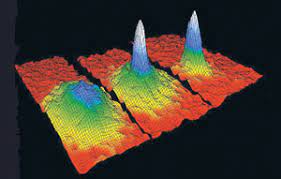Thermodynamics and Statistical Mechanics
 It seems natural that this set of notes should follow the previous four. The previous guys are basically considering the states that particles and fields can exist
in, either from a Classical or Quantum perspective, while Thermo/StatMech describes how a system fluctuates within an ensemble of such states, when isolated or
interacting with its environment. Anyway, in the Thermo notes I tried to develop the material from a very general perspective to counter the notion (and my notion
when I was a student) that it's basically just the study of gasses. I have a friend who studies Chemical Engineering and I was impressed with how the subject is
developed there, with balance equations framing the analysis, and entropy having a central role early on. I tried to match that, and to develop the laws of
Thermodynamics, as well as I could, from basic mechanics. This works out pretty straight-forwardly vis a vis the 1st law, but apropos the 2nd law, well, grain
of salt. I also spent time on non-equilibrium thermodynamics (NETD), since it provides a paradigm for understanding the place for transport coefficients: like
thermal conductivity, electrical conductivity, etc. And it dovetails nicely with Stat Mech. Speaking of that, I tried to make the distribution function the focus
of Stat Mech. The first file discusses what it is, basically. Then I go through the standard ways of finding it in various equilibrium ensembles. Next,
free particle situations are considered, and then when interactions play a non-negligible role, approximate techniques like classical and quantum perturbation
theory are discussed. I also added notes on thermally averaged Green's Functions, Mean Field Theory, and a little bit on RG as well. Then, sort of in parallel
with non-equilibrium thermodynamics, I delved into non-equilibrium statistical mechanics (NESM): Boltzman equation, Kubo formula, and as much as I felt like on the
quantum Boltzman equation.
It seems natural that this set of notes should follow the previous four. The previous guys are basically considering the states that particles and fields can exist
in, either from a Classical or Quantum perspective, while Thermo/StatMech describes how a system fluctuates within an ensemble of such states, when isolated or
interacting with its environment. Anyway, in the Thermo notes I tried to develop the material from a very general perspective to counter the notion (and my notion
when I was a student) that it's basically just the study of gasses. I have a friend who studies Chemical Engineering and I was impressed with how the subject is
developed there, with balance equations framing the analysis, and entropy having a central role early on. I tried to match that, and to develop the laws of
Thermodynamics, as well as I could, from basic mechanics. This works out pretty straight-forwardly vis a vis the 1st law, but apropos the 2nd law, well, grain
of salt. I also spent time on non-equilibrium thermodynamics (NETD), since it provides a paradigm for understanding the place for transport coefficients: like
thermal conductivity, electrical conductivity, etc. And it dovetails nicely with Stat Mech. Speaking of that, I tried to make the distribution function the focus
of Stat Mech. The first file discusses what it is, basically. Then I go through the standard ways of finding it in various equilibrium ensembles. Next,
free particle situations are considered, and then when interactions play a non-negligible role, approximate techniques like classical and quantum perturbation
theory are discussed. I also added notes on thermally averaged Green's Functions, Mean Field Theory, and a little bit on RG as well. Then, sort of in parallel
with non-equilibrium thermodynamics, I delved into non-equilibrium statistical mechanics (NESM): Boltzman equation, Kubo formula, and as much as I felt like on the
quantum Boltzman equation.
|